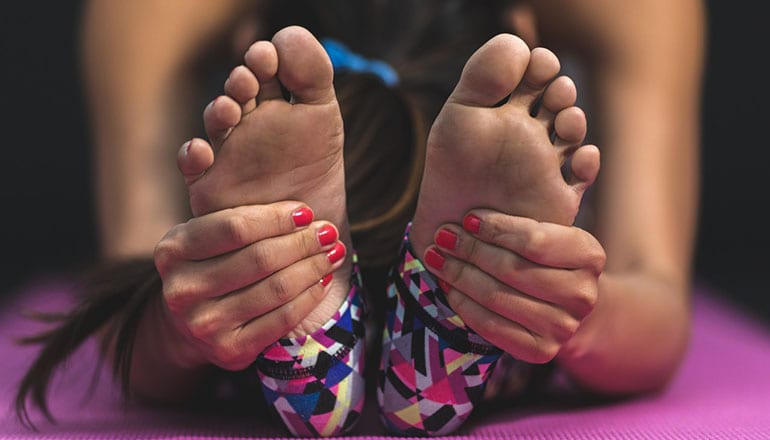Buying shoes is quite often a fun and exciting activity. But for sufferers of flat-feet (like myself), it can prove to be a tedious and overwhelming task. There are many shoes on the market sporting all kinds of cool tech, different designs, and styles, but what are the best shoes for flat feet? There are some essential characteristics to look out for those with flat-feet. This condition is sometimes misunderstood and can cause considerable discomfort to those unfortunate enough to be afflicted by it.
But being flat-footed doesn’t mean you’re limited in any way. An estimated 20% – 30% of the population has some form of the condition which highlights just how common it is among the general public. There used to be a time where people would be disqualified from joining the US Military if they had flat feet (luckily, that is no longer the case).
It was a recognized norm that flat-footers had less tolerance to foot stress than regular people. Studies have shown that people suffering from flat-feet generally experience a lower quality of life due to the various stresses resulting from irregular weight distribution on their feet, back, and hips. But, on the bright side, people with flat-feet can function just as effectively by implementing a few corrective measures.
What are Flat-Feet?
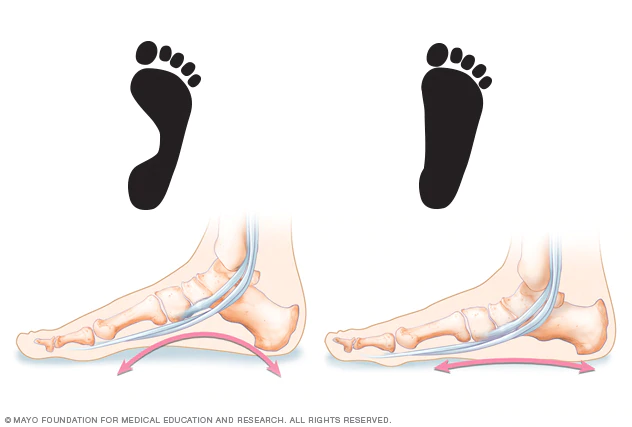
Flat-Feet (also referred to as overpronation) is a relatively common condition where the arches of the feet have fallen, either partially or completely. There are various grades of flat-feet and it is often a condition that is genetic and requires no surgical treatment. It is relatively easy to determine if you have flat-feet – wet your feet and press them on a flat surface to determine your arch type.
If the resulting print is a complete imprint of your foot, then you are highly likely to have flat-feet. Symptoms of flat-feet may include aches on your calves, lower back pain, and constant stabbing pain in your heels. Flat-feet may also contribute to reduced physical activity and low motivation due to the fact that you’re in pain anytime you try to walk a block or two. This makes choosing the right type of shoes incredibly important.
Shoes for Flat Feet
Many of the above-mentioned issues can be easily avoided by buying the right pair of shoes with adequate arch support to make up for what your foot is naturally lacking. It’s also important to keep a note of other conditions you might have apart from flat-feet – like if you’re someone with wide or narrow feet.
In this article, we will identify a variety of shoes that aren’t tailored to a single activity but a whole range of them, for both genders. Whether you’re looking for walking shoes, work shoes or running shoes, there will definitely be a pair here that might catch your interest and help your flat-feet.
1. Brooks Beast ‘18 (Men’s) / Brooks Ariel ‘18 (Women’s)
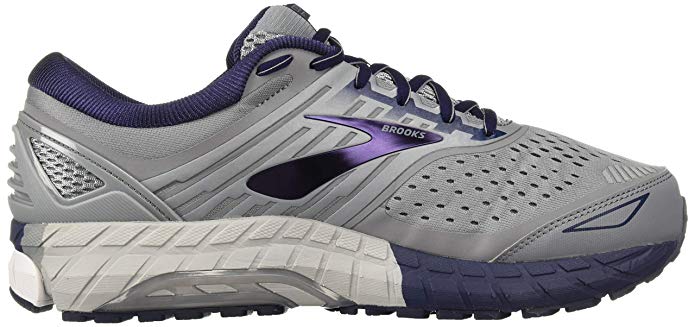
First on our list is this comfortable duo – the Beast and Ariel. Functionally the same, but marketed differently for each gender. These shoes are considered some of the best on the market for flat-feet, as they give you motion-control, stability, and a secure fit. Initially designed with running in mind, these shoes are versatile enough to be used for walking, overpopulation, and flat-footed related ailments as well.
The Beast/Ariel’s have a diagonal rollbar that is designed to keep overpronation in check. The shoes also incorporate an adaptable DNA midsole, kept together by durable moisture-wicking material. The result of this is a shoe that is both comfortable as well as smooth and odor-free.
Easily the biggest drawback of this shoe, though, is that it is high-priced and happens to run a bit smaller. If the price tag isn’t an issue, you should consider getting a half size up for an ideal fit. On top of this, aesthetically some might consider them to be a bit bulky. If you’re someone who wants that “firmly planted” feel, though, there’s no issue.
Pros
+ Straight-forward design
+ Good breathability on the upper
+ Supportive and stable midsole
+ Great for runners with flat-feet
Cons
– High price tag
– Runs half a size small
2. ASICS Gel-Kayano 24 (Sneakers)
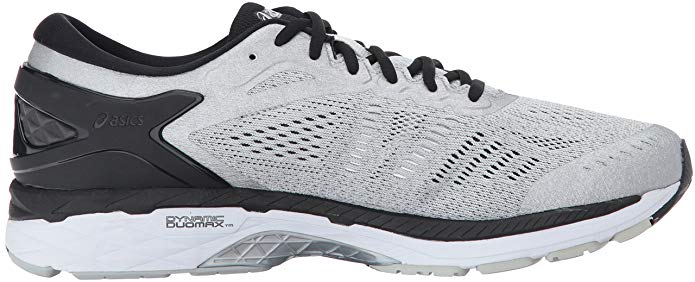
Next up is the unisex Gel-Kayano 24’s by ASICS. This design has been around a long time, and for good reason – it is a top-notch brand with a track-record for making amazing running shoes. The 24’s have a two-layer cushioning throughout the midsole to give your arches support, as well as FlyteFoam Propel and FlyteFoam Lyte, both together forming the FLUIDRIDE system.
ASICS has also provided a gel cushioning system at the heel of the shoe to add even more comfort for your feet. The Kayano’s also feature the Heel Clutch System, an exoskeletal heel counter that gives you ample support for your heel. It does this by minimizing the gap between your heel and the shoe, giving you a better and more comfortable ride.
ASICS’ philosophy is to enhance and mediate your foot’s natural gait, a classic issue for people with flat feet, and does so with its I.G.S technology, guiding your foot into its proper gait cycle while walking or running.
A common problem is the Gel-Kayano 24’s lack of ample toe-box space, with some people needing more room in this area for a more ideal fit. As a result, you are better off buying the Kayano 24’s a half size larger to mitigate this minor design flaw.
Pros
+ Great support for heel and arches
+ IGS technology encourages a natural gait cycle
+ Variety of colorways and ergonomic design
+ Comfortable and stable midsole
Cons
– Not true to size; half a size up recommended
3. KEEN Targhee II Hiking Shoe (Hiking Shoe)
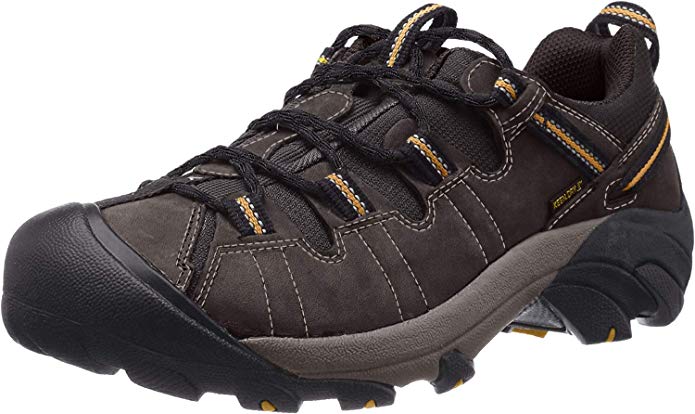
Next up we have the unisex Targhee IIs which are designed to be quality, durable and comfortable hiking shoes. It constructed from 100% waterproof nubuck leather, with a durable rubber outsole and a shaft that is 4.5” from the arch. The low-profile ghillie-style lacing system gives you a comfortable and secure fit.
The padded tongue and padded collar add to its great comfort, with a breathable leather lining to make sure you are also moisture-free in these shoes. When it comes to hiking with flat-feet, these boots are up to snuff, with a dual-density compression-molded EVA midsole to make sure your arch and heel are amply supported and never in a bad or awkward position.
It comes in a surprising amount of alternative colors giving both genders enough of a selection to tell their shoes apart if you’re picking up a pair for two people.
There are two major flaws with these boots that can’t go unnoticed though, the first being that they are consistently half a size small, with the manufacturer recommending you go a half size up for the best fit. And the second issue is that the quality is hit or miss. Some people report that these boots are simply incomparable to anything else on the market, and last forever, while others have theirs break down within months. At the end of the day, it depends on if you’re heavy into hiking or more of a seasonal amateur.
Pros
+ Great hiking boots for folks with flat feet
+ Waterproof nubuck leather construction
+ Durable outsole that can take a beating
+ Wide array of colors to choose from
Cons
– Runs half a size smaller
– Inconsistent quality depending on use
4. Salomon Quest 4D 2GTX (Hiking Boot)
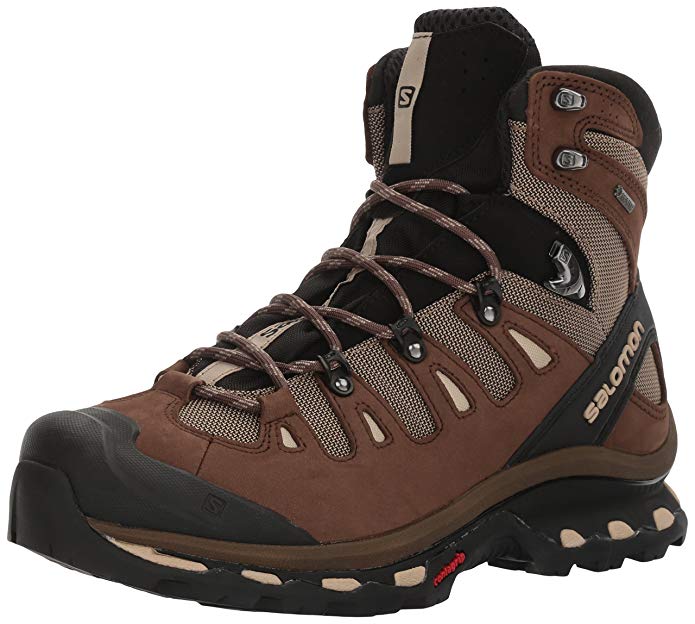
Our second pair of hiking boots that are ideal for those with flat-feet are the Quest 4D 2GTX hiking boots by Salomon. These boots do not skimp out on quality, and incorporate some unique and great features all into one single boot, with gore-tex waterproof protection for murky terrain, and dual-density EVA midsole to give you the comfort and support your flat-feet need.
The boots also have rubber toe caps and heel slings to make sure your toes and upper are free from danger like abrasions or hard knocks. The midsole also consists of a thermoplastic urethane that helps your foot by reducing strain, enhancing overall stability and providing flexibility. This is a highly ergonomic boot with a lot of thought and design put into every aspect of it.
With that said, the design and time put in are clearly reflected in the price, which is fairly high for some people. As a result, be ready to pay for that great quality. If you are looking for a hiking boot that will last a while and give you a smooth ride for your flat feet, and the cost is not an issue, these are a reasonable purchase. If you are looking for a cheaper alternative and are willing to sacrifice some of the quality that comes with it, there are other options.
Pros
+ Ergonomic and stellar design
+ Great multi-terrain boots
+ Midsole and supportive and comfortable
+ High-quality construction
Cons
– High price tag; cost may be a barrier to some
5. Birkenstock Arizona Sandals (Sandals)
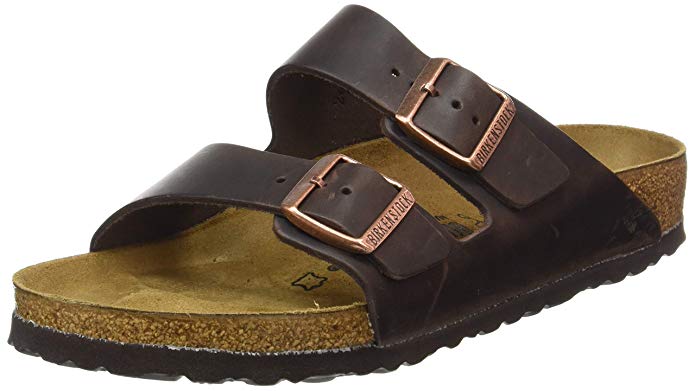
We said we’d include a variety of shoe types for all genders, and we weren’t kidding. Here we have the Birkenstock Arizona Sandal that is unisex. It is a stylish yet comfortable sandal that is also recommended for those with foot conditions such as flat-feet. The design is a straightforward two-strap, with the classic Birkenstock cork footbed.
The footbed is made specifically to mold to your unique footprint and gives you comfort and support in the areas you need it the most while helping your feet rest in a naturally comfortable spot. The soft mold supports your arch area and back of the heel most, a particularly sensitive spot for those of you with flat feet.
Underneath is an EVA sole for extra cushioning and shock absorption, adding to the comfortability while in movement. The Arizona sandals also come in a variety of sizes and have options for narrower or wider feet.
The only major issue is the fact that you’re paying a top-end price for this brand name sandal, which some people would rather not shell out. On the other hand, if you want a pair of sandals that are well-made for people with flat-feet and will last you a long time, then you can’t go wrong with the Birkenstock Arizona.
Pros
+ Cork footbed molds to your unique foot shape
+ Good for the arches and heel area
+ EVA sole helps with shock absorption
+ Classic Birkenstock look
Cons
– Comes at the Birkenstock price
6. AVIA Avi-Union (Women’s Work Shoes)
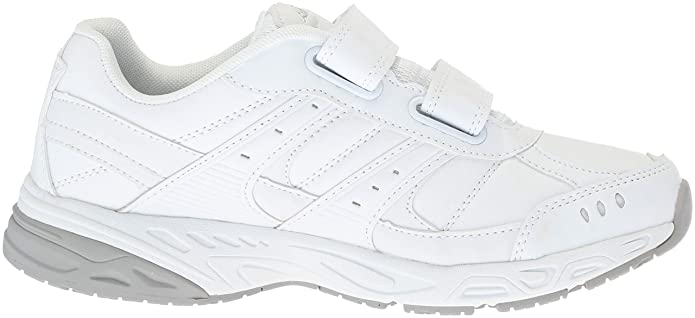
First up on the women’s side are the work shoes by AVIA, the Avi-Unions. These have a completely synthetic upper and sole, with the upper being an imitation leather and coated with Scotchgard for added resistance to water and staining.
Inside the shoe is compression-molded EVA insoles, and a soft-gel unit in the heel for added comfort. There is also a cantilever support system giving you extra cushioning and dispersion of shock, ideal for flat feet that don’t naturally do this as well as a normal foot.
The Avi-Union insole is completely removable as well, in case you prefer to put in your own custom aftermarket pair for added comfort. These are a great versatile work shoe for women, with great traction and resistance, so you’ll never have to worry about your terrain. They are also fairly affordable, which is a cherry on the top.
Unfortunately, the Avi-Unions aren’t very long-lasting, with each pair on average, getting about half a year without needing to be replaced, depending on how much you use them. If that isn’t an issue for you, or you don’t typically give your shoes a beating, then these are a solid choice for flat-feet work shoes.
Pros
+ Durable and resistant upper
+ Slip-resistant outsole
+ EVA midsole with soft gel and cantilever design
+ Affordably priced
Cons
– Not the greatest longevity, expect half a year of serious use
7. KEEN Utility PTC Oxford (Men’s Work Shoes)
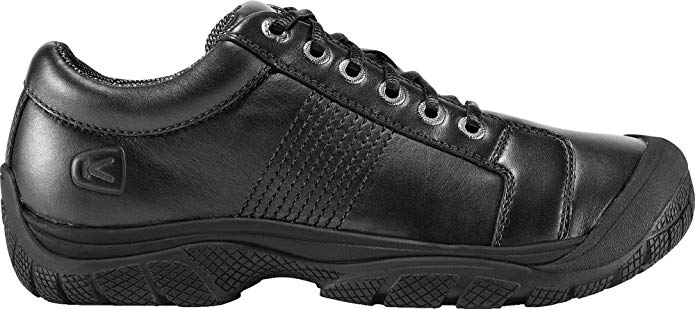
Now we’re getting into the men’s shoes and taking a departure from runners and hiking boots into more casual or work-oriented shoes for flat-feet. First up are the KEEN Utility PTC Oxford Dress shoes. These are made of 100% leather upper with a synthetic sole. The design is aimed to be just below the ankle and contains appropriate padding to enable people with flat feet to work extended hours.
The PTC also features KEENS patented toe protection, where the outsole of the shoe is actually wrapped up and over your toe area for added protection, meeting CSA standards, for those who require it for work. The PTC also has compression-molded EVA midsoles to give your flat-feet all-day comfort and cushioning made from a blend of PU, cork, and memory foam to contour to your foot shape and adjust accordingly.
It gives you the cushioning you’ll need throughout a full day’s shift while on your feet. As for the outsole – on top of providing protection for your toe area, it is also oil and slip-resistant, that meets or exceeds ASTM non-slip testing standards. Overall, it is a high comfort, low-profile work shoe with a sleek design and water-resistant leather that’s easy to maintain, with the credentials to back it up for use in the workplace.
Consequently, similar to the issue that plagued the other KEEN shoe was the fact that the quality is hit-or-miss. Some people have these shoes for years at a time, others for months at best. It appears to be a bit of a gamble as to what you’ll get. If you’re not too concerned with that, though, these are an otherwise fine work shoe that meets several safety standards and helps people with flat-feet that work long hours on their feet.
Pros
+ Meets ASTM and CSA standards
+ Sleek look, comfortable cushioning
+ Midsole is great for relaxing your flat-feet
+ Water-resistant and easy upkeep
Cons
– Quality is inconsistent – sometimes great, sometimes not
8. Trotters Danelle Pump (Women’s Dress Shoes)
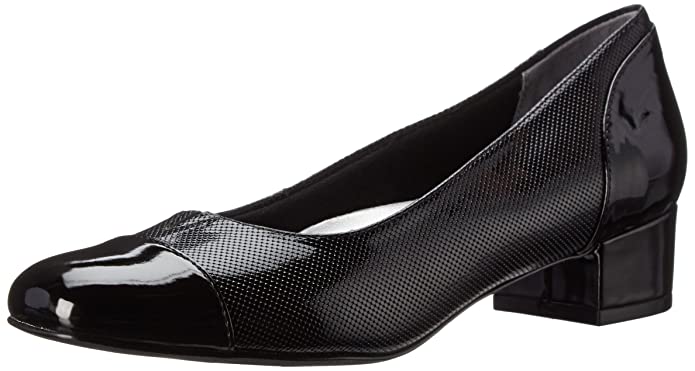
Our first on the women’s side is the Trotters Danelle Dress Pump – which is aimed at people who aren’t in laborious fields and can afford to have a bit of a heel at work without much issue. It has a 100% leather upper with a synthetic outsole. The dress pump features a shiny cap toe and counter with a slit vamp and thick heel.
The insole is certified anti-impact EVA, great for absorbing shock and keeping your flat-foot at ease. There is a slightly raised arch to give your flat-feet added support and stability. This is an attractive shoe with a lizard-esque suede upper giving it a unique look that feels more pricey than it actually is.
The heel is purposefully thick, as to be more durable and stable. Overall this is a good pick for women who want to balance form with functionality in a workplace that allows it. These shoes are meant for women with mild to moderate overpronation.
The Danelle Dress Pumps tend to run a little small though, so you’ll likely need to purchase them a half size or so bigger than your true foot size as to have the most ideal fit and comfort. Fortunately, they also come in a wide option for those of you with wide feet, which is a definite perk.
Pros
+ Elegant design
+ Midsole and arch cookie helps support flat feet
+ Shock absorbent and stable
+ Available in wider sizes
Cons
– Tends to run a half size smaller
– Not ideal for people with severe overpronation
9. Dunham Burlington Oxford (Men’s Dress Shoes)
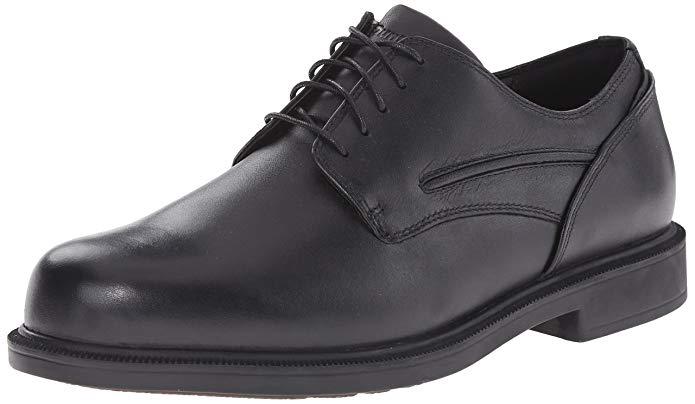
These work shoes are meant for men who need to dress business casual or want to have a versatile pair of shoes that are also very comfortable for being on foot all day long. The sizing options are incredible, going from size 7 to 20, with narrow to XX-wide being available.
It goes without saying that no matter the dimensions of your foot, Dunham’s Burlington Oxford has a shoe for you. They have a 100% leather upper, a removable footbed to put in any additional after-market insole systems you prefer, and moderate arch support for flat-feet right out of the box.
These shoes are Medicare-approved as diabetic shoes for those who have flat-feet as a result of diabetes. The Burlington Oxford is an ideal choice for men with flat-feet who want to dress smartly. They are minimalistic and sleek shoes that are great if you have a job that requires a certain dress code while also being on foot frequently.
There are a few drawbacks of the Burlington Oxford’s, though, namely the fact that it can scratch and crease easily. Unfortunately, this is a common trait of many leather products and for some, very much a deal-breaker.
If you don’t particularly care about a few creases or scuffs, just want a pair of simple shoes that deal with your flat feet effectively, then the Burlington Oxford’s are fine.
Pros
+ Sharp looking dress shoes
+ Moderate arch support for flat feet
+ Comes in every size and width imaginable
+ Removable footbed
Cons
– Leather creases easily
– Requires a lot of care and maintenance
10. Dansko Jenna Flat (Women’s Flats)
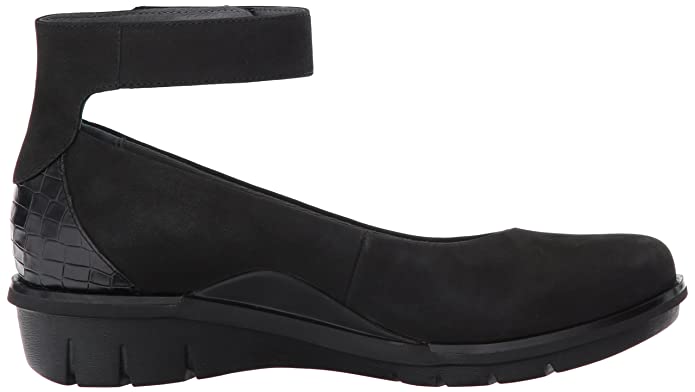
The shoe rounding out our list is the Jenna Flats by Dansko. These are a woman’s nubuck leather shoe that is constructed with 3M Scotchgard treatment and highly stain resistant. It lasts a fairly long time with a stitched leather welt, and when it comes to flat-footed comfort, it hits it out of the park.
The shoes have a durable EVA outsole that gives great shock absorption, and an integrated insole with custom tuckboard and shank to provide your feet with support and stability you may be lacking. The built-in heel is not particularly prominent, being roughly half an inch off the ground.
The Jenna’s have a wide toe box for a roomy feel, slip-resistant outsole and open PU footbed with ample arch support. Overall, these are a solid pick with great style, a part of the Juno Collection, and great functionality, supporting your fallen arches well.
The only significant issue the Jenna flats have is the fact that they are a bit on the expensive side, even for office-work oriented shoes. They are expensive but last a fair amount of time, and you may be able to find them for a deal if you scour Amazon.
Pros
+ Elegant design and quality construction
+ PU footbed offers good arch support
+ Leather upper and slip-resistant sole
+ Durable welt construction
Cons
– Fairly pricey unless you snag a deal online
Tips for Picking Shoes for Flat Feet
This guide will serve you with the best tips and choices for picking the right shoes for flat-feet whether it be walking shoes for flat feet, running shoes for flat feet or training shoes. Over the past 8 years, I have been on a quest to try and solve my flat-footedness without resorting to invasive procedures (aka surgery). The treatment for this condition ranges from orthopedic implants to physical therapy or simply just swapping for a pair of shoes designed for flat-feet. It is imperative that if you have this condition and it is causing you significant discomfort, you should see a doctor immediately as there could be some other underlying factors besides flat-feet.
After being diagnosed, it is of utmost importance to provide the best support to your feet, so the condition does not worsen or cause you further pain. This is why your selection of shoes can be incredibly relevant to how the condition affects your life. Shopping for the best shoes for flat feet can be made far less stressful by following these simple and effective tips:
Shop for Shoes Later in the Day
The first tip is to always shop for shoes later in the day. You may be wondering what difference this would make. Your feet swell ever so slightly during the day, and this little difference can prove decisive when testing the comfort of a pair of shoes. It stands to reason that to pick out the right shoe that will stay comfortable throughout the day, it is better to go try on shoes later in the day.
This will allow you to pick the shoes that provide the best comfort as they will be a better fit than ones you may have selected first thing in the morning. These tiny differences can have the most significant results when it comes to finding the best shoes for flat feet that are comfortable and supportive.
Be Wary of Size Variations
One important thing to keep in mind is that sizes vary wildly between brands. You cannot, therefore, assume that a size 8 of one brand will fit the same in another brand of similar size. The discrepancy in sizes can be particularly daunting to someone with flat-feet since these size differences can cause considerable discomfort.
The width of the shoes can also vary between brands and finding a pair with the right size and width will determine the overall fit of your shoes. When dealing with flat-feet, it is extremely important to make sure that the shoes are a good fit. If your shoes are too tight, they can cause pain and discomfort. If they are too loose, your feet will fatigue faster due to improper arch support.
It is imperative that you keep an open mind when dealing with size variations and not assume you will only fit into just that one size. Shoes for flat feet generally have arch support, so it’s important to keep this in mind.
Remember Your Socks
One of the most overlooked items when picking out shoes is the socks that you are wearing. This is not usually a thought that enters most people’s minds. Nonetheless, the type of socks you are wearing can make a huge difference in the overall comfort of your shoes. With this in mind, during shoe trials, you should always wear the socks you intend to wear regularly. This will give you the optimum fit and ensure your shoes wrap snugly around your regular socks.
Sometimes, the type of shoes you are buying will directly influence what sock you’d be wearing. For example, if you’re shopping for hiking boots, chances are that you will be wearing thicker hiking socks. And if you’re buying running shoes for flat feet, you should pick thinner sports socks. The thickness of your socks will have a direct impact on the comfort of your shoes. You don’t want to be that guy (or gal) wearing thick hiking socks with your running shoes on a bright sunny morning.
Allow Adequate Toe Space
Another size consideration that you should always keep in mind is the space between your big toe and the tip of the shoe. As a general guideline, you should leave about a thumbnail space in this area to allow for flexible wiggle room.
If your big toe is pressed against the fabric of the shoe, then this will eventually become uncomfortable with prolonged use. Some may suggest that your shoes will expand as you break them in. But, keep in mind that your footwear will only expand ever so slightly and not something you should rely on.
Once you’ve accounted for the toe gap, test the fit of your shoes by pushing your feet all the way to the front of your shoes and sliding an index finger behind your heel. If your finger doesn’t fit, then go half-a-size up and try again.
If it slides in too easily, consider dropping down half a size. If you keep this size consideration in mind, you are much more likely to purchase a shoe that will provide lasting comfort throughout the day. It is crucial to get the perfect fit as this will lead to much lower foot-fatigue down the line.
Consider Wider Styles
You should check if you have wide feet as well as flat-feet. There are many shoes available in extra wide variations that aren’t commonly known. Selecting wider styles can make a huge difference in comfort levels to those with a wider footprint. If your favorite pair does not come with a wider style, then you may consider going a half-a-size to a size up to find a proper fit.
It is important to explore all the options at your disposal to find your ideal fit. It should be noted that you shouldn’t pick too wide a width in your shoes since you’d want some sort of arch support for your flat-feet and this can often be mistaken for narrow shoes. The width can play a major role in determining the support level for your flat-feet.
Get Accustomed to Your Shoes
One way to get a good feel for your shoes is by wearing them around the house before taking them outside. If you spend some time in your shoes, you will start to get a feel for them. This will also come in handy if you decide to return them as shoe manufacturers/retailers usually have a generous return policy in place.
Take it from a guy that loves shoe shopping – few things in life are as fulfilling as wearing your new kicks outside for the first time. It brings about an air of confidence and contentment. The time spent getting adjusted to your new shoes can make the experience of regularly wearing them far more comfortable.
Replace Your Old Worn Out Shoes
It goes without saying that you should replace your old shoes regularly. But, how exactly can you tell that they have become old? If your shoes have either widened from regular use, or the outer sole shows visual signs of degradation, this is when you know it’s time for a new pair.
It is easy to get attached to old shoes, but this attachment should fade once you realize that the gradual loosening of them greatly reduces the support they provide to your feet. This can contribute to foot pain and make the shoes increasingly uncomfortable to wear.
As a general rule of thumb, it is recommended to replace shoes after every 300 miles of use. This may seem like a relatively high number, but people often underestimate how much they walk and run on a regular basis. Not sure if you’ve done 300 miles? Then use the ye-olde eyeball test and look for visible signs of degradation. Luckily, we have prepared the most important things to look out for when you buy your next shoes.
Use insoles made for flat-feet
Let’s face it – not all shoes your heart desires are made for flat-feet. Those designer lifestyle shoes you’re eyeing may not be very benevolent to your feet. This is where insoles for flat feet come in handy and act as a buffer between your feet and the shoes. Keep in mind that insoles can sometimes be inconvenient especially when they shift around in your shoes, and hence should only be used as a temporary measure.
They’re not a replacement for shoes which are purpose-built for flat-feet, but they get the job done for those few occasions where you might want to dust off your dress shoes to impress at your annual board meeting.
Shoe inserts are made from a variety of different materials like gel, foam or a mix of foam and rubber. Some inserts are made purely for added comfort while others are made for conditions like flat-feet and plantar fasciitis. Flat-footers should opt for inserts with sufficient arch support. It’s also important to note that the arch support on your insoles should neither be too soft and squishy, or too firm and hard.
Conclusion
It is important to note that if after following these tips, you still find it difficult in picking out your next best shoes for flat feet, or you’re experiencing protracted pain and discomfort, you should see a doctor immediately as there may be other underlying factors besides flat-feet causing this.
As a flat-footer myself, I own a different pair of shoes for different activities. It’s generally not advisable to follow a “one-shoes-to-rule-em-all” policy. This is because running shoes are designed differently to training or workout shoes and vice-versa. Some of the best Running shoes, for example, are made with added cushioning to absorb shock with each stride in a linear motion. They lack support for lateral movements that you typically experience in a gym (jumping squats, anyone?).
